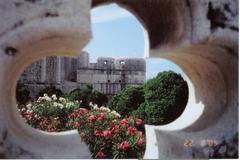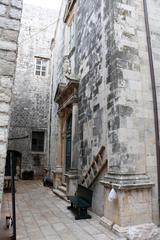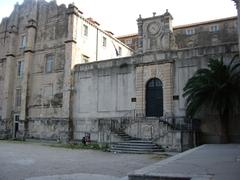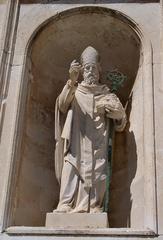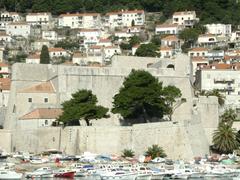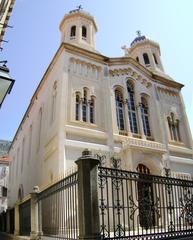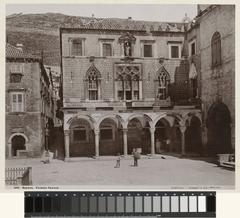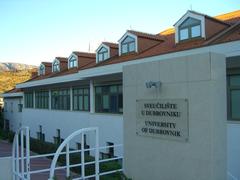
House of Marin Držić Dubrovnik: Visiting Hours, Tickets, and Complete Historical Guide
Date: 04/07/2025
Introduction: Discovering a Renaissance Literary Treasure in Dubrovnik
Located in the heart of Dubrovnik’s UNESCO World Heritage Old Town, the House of Marin Držić is a premier cultural attraction dedicated to the legacy of Marin Držić (1508–1567), Croatia’s most illustrious Renaissance playwright. This meticulously preserved Renaissance townhouse immerses visitors in the vibrant social, political, and artistic world of 16th-century Dubrovnik—then the independent Republic of Ragusa.
Držić is celebrated for his satirical comedies, such as “Dundo Maroje” and “Novela od Stanca,” which not only shaped Croatian literature but also provide enduring insights into the cosmopolitan society of his era. The museum, established in 1989 to mark the 400th anniversary of Držić’s death, serves as both a cultural monument and a dynamic hub for theatrical performances, workshops, and scholarly research. Its central location on Široka ulica, near the bustling Stradun promenade, ensures accessibility for visitors interested in literature, Renaissance architecture, and Dubrovnik’s layered history.
This guide consolidates everything you need to know for planning your visit: current opening hours, ticket prices, accessibility, highlights, and practical travel tips. It also recommends nearby attractions such as the Rector’s Palace and Dubrovnik Cathedral, for a richer exploration of the city’s heritage. For the most up-to-date details and event schedules, consult the official museum website and the Dubrovnik Tourist Board.
House of Marin Držić: Historical and Cultural Context
Marin Držić: Life and Literary Legacy
Marin Držić was born in 1508 into a respected Dubrovnik family. He studied in Siena, Italy, where Renaissance humanism significantly influenced his writing. Upon returning to Dubrovnik, Držić became a priest and organist, but his literary pursuits soon took center stage. His satirical works, including “Dundo Maroje,” “Novela od Stanca,” and “Skup,” are hallmarks of Croatian Renaissance theater, known for their sharp wit and social commentary (Croatian Encyclopedia).
Držić’s plays critiqued Dubrovnik’s elite and reflected the city’s dynamic, multicultural environment. His political activism led to exile, and he died in Venice in 1567—a testament to the turbulent times in which he lived (UNESCO World Heritage Centre).
The Museum: Architecture and Evolution
The House of Marin Držić is not Držić’s original family home but was chosen for its authentic Renaissance architecture and proximity to key sites from his life. The restored townhouse features a stone façade, wooden beams, period furnishings, and original manuscripts, offering a vivid glimpse into daily life in 16th-century Dubrovnik (House of Marin Držić Official Site).
After sustaining damage during the Siege of Dubrovnik (1991–1992), the museum was carefully restored with support from both local and international organizations. Restoration efforts preserved its Renaissance character while making it suitable for modern visitors (UNESCO World Heritage Centre).
Planning Your Visit: Opening Hours, Tickets, and Accessibility
Opening Hours (2025)
- April – October: Daily, 9:00 AM – 6:00 PM
- November – March: Tuesday to Sunday, 10:00 AM – 4:00 PM (Closed Mondays)
- Major public holidays: Closed
Ticket Prices
- Adults: 50 HRK (approx. €7)
- Students & Seniors: 30 HRK
- Children under 7: Free
- Dubrovnik City Card: Entry included for pass holders
- Tickets available at the entrance or online via the official website.
Accessibility
- The main entrance is wheelchair accessible, but some upper floors have limited access due to the building’s historic structure.
- Staff are available to assist visitors with mobility needs. Visitors are advised to contact the museum in advance for specific accommodations.
- Exhibition texts and audio guides are available in Croatian and English.
What to See: Visitor Experience and Museum Highlights
Museum Layout
- Ground Floor: Introduction to Držić’s life, Renaissance Dubrovnik, and the playwright’s cultural impact.
- Upper Floors: Period room reconstructions, including a 16th-century study and bedroom with authentic furnishings and artifacts. Displays include rare manuscripts, Držić’s personal correspondence, and early editions of his works (Time Out Croatia).
- Interactive Audio Guide: Available in English, offering engaging narration and theatrical storytelling to immerse visitors in Držić’s world.
Exhibits and Activities
- Original Manuscripts & Rare Books: View Držić’s handwritten letters and early printed editions.
- Period Costumes & Artifacts: Experience Renaissance fashion and daily life.
- Multimedia Installations: Audio-visual presentations and digital reconstructions bring the era to life (Real Journey Travels).
- Theatrical Performances: Regular stagings of Držić’s works, especially during the Dubrovnik Summer Festival and Marin Držić Days.
- Educational Workshops: Interactive sessions on Renaissance theater, costume design, and literary history, popular among families and school groups.
Amenities
- Gift Shop: Books, souvenirs, and Držić-themed memorabilia.
- Restrooms: Clean facilities available for visitors.
- No On-site Café: Numerous dining options nearby in the Old Town.
Nearby Attractions: Enhance Your Dubrovnik Experience
Combine your visit to the House of Marin Držić with other major Dubrovnik historical sites:
- Rector’s Palace
- Sponza Palace
- Franciscan Monastery
- Dubrovnik Cathedral
- Dubrovnik City Walls
Many sites are included with the Dubrovnik City Card for added value (Shipped Away).
Special Events & Festivals
- Marin Držić Days: Annual festival featuring performances, readings, and special exhibits in honor of Držić’s birthday.
- Evening Events: Candlelit readings, Renaissance music, and interactive storytelling (advance reservations recommended).
Practical Tips for Visitors
- Best Time to Visit: Mornings or late afternoons for a quieter experience.
- Duration: Plan for 30–60 minutes, or longer if attending a performance.
- Tickets: Buy online in advance during peak season or for special events.
- Accessibility: Contact the museum ahead for mobility assistance.
- Photography: Permitted in most areas—no flash or tripods.
Frequently Asked Questions (FAQ)
Q: What are the current opening hours?
A: April–October: Daily, 9:00 AM–6:00 PM; November–March: Tuesday–Sunday, 10:00 AM–4:00 PM; closed Mondays and major public holidays.
Q: How much are tickets?
A: 50 HRK for adults, 30 HRK for students/seniors, free for children under 7; included with the Dubrovnik City Card.
Q: Is the museum wheelchair accessible?
A: The entrance is accessible; some upper floors may not be. Contact the museum for assistance.
Q: Are audio guides available?
A: Yes, in English and Croatian, for a nominal fee.
Q: Can I visit other museums with the same ticket?
A: Entry is included with the Dubrovnik City Card, which grants access to several city museums and attractions.
Conclusion and Recommendations
The House of Marin Držić stands as a vital link to Dubrovnik’s Renaissance heritage and Croatia’s literary tradition. Through its authentic architecture, engaging exhibits, and dynamic programming, it offers visitors a rare opportunity to connect with the city’s intellectual and artistic past. Whether you are a literature lover, history enthusiast, or cultural traveler, a visit here promises inspiration and insight.
For the latest ticket prices, events, and accessibility details, visit the official House of Marin Držić website and the Dubrovnik Tourist Board. Enhance your experience with the Audiala app’s immersive audio guides, and follow related articles and social media channels for ongoing updates about Dubrovnik’s historical treasures.
Image suggestion: Feature photos of the House of Marin Držić’s exterior, interior displays, and Marin Držić Days performances with descriptive alt text such as “Exterior view of the House of Marin Držić in Dubrovnik’s Old City.”
Sources
- House of Marin Držić Official Site
- Dubrovnik Tourist Board
- Hello Dubrovnik
- Real Journey Travels
- The Dubrovnik Times
- Shipped Away
- UNESCO World Heritage Centre
- Time Out Croatia
- Croatian Encyclopedia


